
Chemoradiotherapy (CRT) refers to the combination of chemotherapy and radiation therapy. CRT is considered to be the standard-of-care treatment for many cancers. The treatments can have side effects including fatigue, nausea, vomiting, skin changes, and organ-specific damages. The side effects are due to the non-specific nature of the therapy. In other words, the therapy kills not only cancer cells, but also nearby healthy cells. Since these side effects reduce a patient's quality of life, many researchers have been trying to find ways to lessen the damage to healthy cells.
A major area of study involves radiation therapy. Photon therapy and proton therapy are two types of radiation therapy. Photon therapy is more commonly used. Proton therapy has been around since the 1950s and is regarded by many experts as the more precise option, but it is not widely used. This is thought to be due to several reasons, including very high initial costs and technical difficulty. However, over the past years, technological advancements and decreasing costs have led to increased use of proton therapy.
A recent study was done to compare proton CRT with photon CRT. The study found that adults with non-metastatic cancer who were treated with proton CRT had less unplanned hospitalizations due to side effects, compared to those who were treated with photon CRT. However, there was no significant difference in disease-free survival or overall survival outcomes between the two groups.
This study suggests that using proton therapy instead of photon therapy may have benefits for some cancer patients and highlight an important area for further research.
https://visualsonline.cancer.gov/details.cfm?imageid=2421
